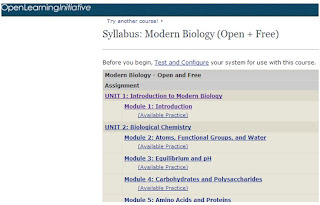The Impact of Open
Source
The Open Learning Initiative created by Carnegie Mellon
University has developed a number of open and free courses with full access to
the course management system via the internet.
Critically examining the Biology course for meeting
recommendations as suggested by Simonson, Smaldino, Albright, & Zvacek
(2012),
the home/main page of the course lists six units, each with sub-modules
(Syllabus, n.d.). The learner can click on the unit link and when finished they
are directed back to the home/main page to continue through the course in a
distinctly linear manner. The main/home page is also the syllabus for the
course, for which it could be argued, makes the course navigation that much
more efficient (Syllabus, n.d.).

In terms of Assessment
guidelines, the course content contains quizzes, self-assessments, and short
answer exams (Simonson, et al., 2012). However, elements that are missing in
terms of assessment are papers/essays, projects, and discussion groups. Facilitation
of discussion groups in a open free course would be more difficult to moderate
and coordinate, since students learn at their own pace and participate as
needed. Learning outcomes, called learning objectives in the Modern Biology
course, were distinctly listed at the beginning of each module to focus on the
learning goals (Syllabus, n.d.).
Pre-Planning
From an instructional
design perspective, I would say that there was pre-planning for this course,
otherwise there would not be so many interactive media technology tools
included in the program. Also, the quizzes were not traditional but interactive
quizzes with visual representations.
Maximizing
Active Learning
Despite the fact that this course was an open-course without an
instructor to guide aspects such as grading, group projects, or discussions,
there could have been more done to maximize the learning experience for
distance learners. Some modifications could include asynchronous discussion
forums by topic. Students could add their viewpoints and reflections and have
the ability to view the posts of previous or current students. On a topic such
as biology, a project could be proposed for the student to work on his/her own.
References
Simonson,
M., Smaldino, S., Albright, M., & Zvacek, S. (2012). Teaching and
learning at a distance: Foundations of distance education (5th ed.) Boston,
MA: Pearson.
Syllabus: Modern Biology (Open +
Free). (n.d.). Open Learning Initiative. Retrieved from https://oli.cmu.edu/jcourse/lms/students/syllabus.do?section=0bb0c42880020ca600b504a8a5daae29.

No comments:
Post a Comment